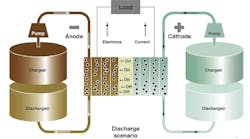The shift to renewable energy and other distributed energy resources (DERs) is underway, marking a pivotal change in the energy landscape. Known as the energy transition, this shift will be necessary to address the new and evolving reality of the power grid. The evolution to DERs provides the opportunity for needed grid modernization, increased reliability and greater resilience.
Seventy percent of the U.S. electric grid infrastructure exceeds 25 years in age. Compounding this, compared to two decades ago, the daily reliance and use of the grid has increased significantly, placing a strain on its aging infrastructure. Current grid capacity is no longer sufficient to meet the growing demand for energy, which is projected to be 14% to19% higher in 2030 than current levels. The energy transition is here and our recent research explores its progress in the U.S. while identifying the barriers to implementation faced by utilities and commissioners.
The move from fossil fuels to renewable energy sources is an important topic for the utility industry. Our survey of 250 U.S. utility executives and 10 state public utility commissioners reveals that the energy transition is considered a crucial shift; 88% of utility executives agree that the switch to renewables from fossil fuel sources is very or extremely important. However, regional differences are evident. While 95% of executives in western states deem the switch as very or extremely important, one in five executives in the Northeast say it is just somewhat important. Although the switch to renewable energy sources is a priority, more than half of utilities in the U.S. have not yet begun their implementation strategy.
The Opportunities are Endless
The energy transition, though difficult, presents an opportunity to build a responsive, intelligent grid. With 94% of utilities either in the planning or implementation phase of their energy transition journey, recognizing the possibilities of such a grid is crucial. One in five utility executives prioritize edge intelligence for the transition, enabling real-time visibility and control over grid operations. These capabilities enhance grid reliability and resilience through real-time issue identification and resolution, empowering utilities to modernize the grid with intelligence and serve communities more efficiently than ever before.
One way that utilities can implement intelligence at the grid edge is by deploying advanced metering infrastructure (AMI), a network of smart meters and sensors that collect real-time data on energy consumption, grid stability and equipment performance. This data provides utilities with a comprehensive understanding of the grid's current state, enabling them to make informed decisions and quickly respond to changes in the grid. AMI facilitates the implementation of automated load management systems, which can optimize energy usage and balance supply and demand in real-time. By leveraging grid-edge technologies, utilities can effectively manage the energy transition, ensure safe and reliable service delivery and keep costs affordable for their customers.
Utilities and Commissioners Recognize the Barriers to Implementation
When asked what they consider to be the top roadblock to the energy transition, 50% of utilities listed infrastructure updates and grid modernization, acknowledging the difficulties of ushering in a new energy future while relying on an old, insufficient grid. The next barriers seen are the regulatory approval process and a lack of upfront investment funding. Utilities also mirror a common concern with commissioners, listing reliability and resilience as the third most prominent obstacle.
Fifty percent of commissioners view affordability/economics as the largest roadblock to the energy transition utilities face. New investments bring upfront costs, which are further impacted by supply chain challenges and inflation-related issues. The next barriers identified for commissioners are infrastructure siting and interconnection/transmission, followed by reliability/resource availability/storage.
Despite these hurdles, there is a road ahead. The energy transition is a complex undertaking, but it is essential to address the challenges of climate change and ensure a sustainable energy future for the U.S. By working together, utilities, commissioners and policymakers can overcome these obstacles and pave the way for a cleaner, more resilient energy grid.
The Role of the Consumer
As part of this research, utilities were asked to identify the most effective tactics for overcoming the barriers mentioned earlier. The executives emphasized investing in technology and infrastructure to integrate renewables, educating and advocating for clean energy policies with regulators and policymakers, and educating consumers about clean energy and efficiency.
Forty three percent of utility executives believe that consumers play a crucial role in the transition, and nine out of ten state utility commissioners concur. To accelerate the energy transition, utilities say consumers must understand the importance of sustainable energy (58%), adopt energy-efficient appliances and systems (54%), and participate in demand response programs (51%), which allow them to adjust their energy usage according to grid requirements.
Preparing for the Energy Transition
While the precise nature of the future grid is still evolving, utilities must act now to prepare. The first step is to assess the current situation. This involves evaluating the service network's status, identifying components that require upgrades regardless of the energy transition and implementing intelligence at the grid edge. This will help utilities prepare for the future grid.
Next, utilities will need to make the case for funding. The energy transition requires significant investment, and state utility commissioners have acknowledged the constrained nature of financial resources. To ease the regulatory burden of approving petitions for energy transition investments and incentives, utilities should present the most robust business case possible before filing petitions. This involves aligning all stakeholders behind the goal and building a consensus before approaching the state commission.
Industry associations can be invaluable assets in securing funding for transition projects. They serve as reliable sources of regulatory updates, and many offer programs designed to assist utilities in obtaining the funds needed to accelerate the energy transition. By working with these associations, utilities can streamline the funding process and make it more efficient.
All Hands on Deck
The state of the grid will continue to evolve as the energy transition unfolds. It’s clear the grid will need to change to handle widespread electrification that requires greater flexibility and capacity; from increased EV adoption to growing cloud computing centers to higher air conditioning use in rising temperatures. An innovative mindset and leveraging cutting-edge technology will be invaluable in moving the energy transition forward.
While it is impossible to predict the state of the grid five years from now, we can expect it to be far more complex than it is today. It will demand a large, collaborative effort among technology providers, policymakers, consumers, lawmakers and utilities to address both the greatest challenge and opportunity utilities and commissioners have faced in generations: creating a cleaner, more resilient energy future.
Marina Donovan has more than 20 years of global technology marketing and public relations experience with a background in data security, networking and mobile. She joined Itron as vice president of global marketing & public affairs in January 2018. Prior to joining Itron, she was vice president of marketing for Silver Spring Networks, where Marina led all aspects of outbound marketing including branding and corporate positioning, demand creation, events, product marketing, public relations and web properties. Prior to joining Silver Spring, she held executive marketing positions at IronKey by Imation, Syniverse, VeriSign and RSA Security. Marina holds a Bachelor of Arts in public relations from San Jose State University.


